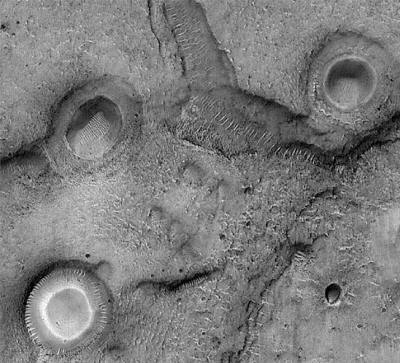|
|
|
October 12, 2011 from Thunderbolts Website
Mare Acidalium
quadrangle on Mars
Credit:
NASA/JPL/University of Arizona
According to a
recent press release, a new theory
claims to explain how the planet Mars acquired its red color and its
tortured, barren, and desiccated landscape.
Why does the planet appear to have been devastated from pole to pole?
Dr. John Brandenburg, co-author
of "Dead Mars, Dying
Earth," (similar writing "Evidence
of a Massive Thermonuclear Explosion on Mars in the Past") suggests that an immense nuclear
explosion - albeit a natural one - destroyed Mars almost 200 million
years ago.
In Franceville, Gabon, scientists noticed
that there was an unexpected three-thousandth of a percent
difference between expected values of uranium 235 compared to
uranium 238 in their spectrographic analyses of rock samples.
Particular isotopes of xenon gas
in the uranium deposits in
the "Oklo reactor" region of Gabon
are said to indicate that a natural nuclear reaction burned for
thousands of years until the fissile uranium was exhausted.
The million megaton atomic detonation is supposed to have scattered radioactive dust from Mare Acidalium all over the planet. The increased detection of xenon 129 isotope radiation is supposed to confirm the connection between Gabon and Mars.
Several factors in both the Gabon and Mare Acidalium theories might lend themselves to other explanations when the time of both observations is adjusted.
Rather than 200 million, or two billion
years, what if both anomalies were created in the same more recent
events?
The truth is that the Martian terrain presents definitive evidence of electric arcing to the surface in a global re-sculpting of the planet. Much of the evidence involves enigmatic dendritic ridge systems or "Lichtenberg Figures."
We see this sharply carved relief along hundreds of miles of the gigantic Valles Marineris. Identical morphologies appear on both the "caldera" walls of Olympus Mons and its miles-high scarp.
The same formations stand out on great mesa cliffs, along the walls of extensive rilles, and even on the rims of huge craters. These unique configurations cry out for a common explanation, but conventional geology has nothing to offer.
As documented in the video presentation,
"The
Lightning-Scarred Planet Mars," laboratory experiments
readily produce the forms with electric discharge.
From the great trench Valles Marineris, to the so-called "volcano" Olympus Mons, to the vast (900 km) crater in Argyre Planitia, to the strangely terraced mounds in Arabia Terra, as well as both Martian poles, the planet's surface offers what could well be the most promising laboratory in the solar system for testing electric discharge explanation of planetary surface.
In other articles on this site, we've
discussed the experiments of Dr. C.J. Ransom, who replicated
the hematite
spherules ("blueberries") that litter the
Martian landscape by blasting a bed of hematite with an
electric arc.
What could account for kilometers long fields of broken glass shards like those in Egypt or large sheets of "Darwin glass" from Australia?
Surely the most reasonable explanation based on laboratory experiments, not wild theoretical leaps, is provided by planetary-scale cosmic thunderbolts, melting and fusing the soils into glass.
Perhaps the timeframe will be difficult
to establish so long after the events, but the question of cause can
no longer be avoided..
|


